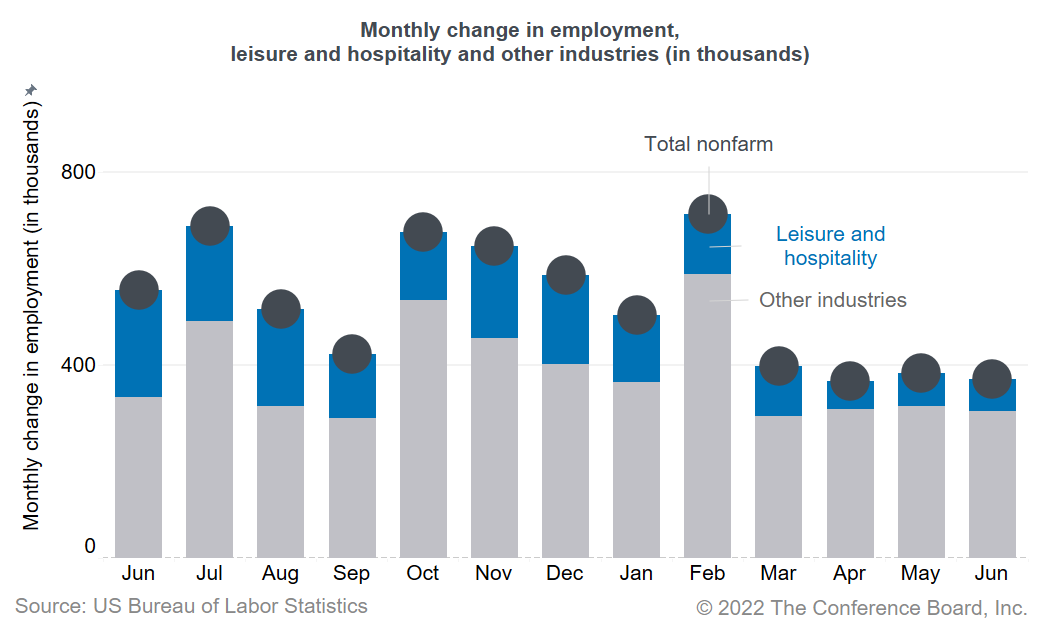-
Email
Linkedin
Facebook
Twitter
Copy Link

Loading...
The labor market continues to be strong, with 372,000 jobs added in June 2022, after a downwardly revised increase of 384,000 jobs in May. Despite gathering economic headwinds, there is still no clear indication that the labor market is cooling. However, this could change in the months ahead as other economic indicators have already signaled that economic activity is slowing amid rising inflation and Fed interest rate hikes. As a result, hiring may decelerate during the remainder of the year. The unemployment rate remained at 3.6 percent for the fourth consecutive month. The labor force participation rate fell slightly to 62.2 percent, down from to 62.3 percent in May. Overall, employment is near its pre-pandemic level, down only 0.3 percent compared to February 2020, representing about 500,000 jobs. Job recovery has been slower for women, with employment still 0.5 percent below pre-pandemic levels, compared to 0.2 percent for men. Job growth remains strong in leisure and hospitality, which added 67,000 jobs in June. After losing jobs in May, retail trade gained 15,400 jobs. Jobs were also added in transportation and warehousing (35,500), professional and business services (74,000), and health care and social assistance (77,800). Hiring also continued in temporary help services (5,400)—one of the better leading indicators of future employment changes in other industries. Wage growth is still elevated, although it seems to have plateaued. Average hourly earnings grew 5.1 percent over the last 12 months and have remained between 5 and 6 percent (annual growth) since Q4 2021. The labor market is still very tight and continued hiring and retention pressures will keep wage growth elevated. Faster wage growth, in turn, will make it harder for price inflation to decelerate as companies will increase product and service prices to cover for increasing labor costs. Today’s jobs report does not support the argument that we are in recession presently and shows the labor market is strong enough to weather additional interest rate hikes. However, with the Fed planning to rapidly raise interest rates over the coming months to fight high inflation, the risk of a short and mild recession in the near future is high. Currently, The Conference Board projects economic output to contract slightly in Q4 2022 and Q1 2023. If there is a short and mild recession, companies would likely start to reduce hiring in reaction to slowing economic activity. The chances of layoffs would also increase and primarily impact lower-skilled workers. With hiring usually adjusting to economic activity a few months later, there could be small monthly job losses by early 2023. As a result, the unemployment rate—in June remaining at 3.6 percent—would tick up. Still, the unemployment rate may well stay below 4 percent following a short and mild recession. This would mean labor shortages will continue to be a challenge for employers in 2023 and beyond.Commentary on today’s U.S. Bureau of Labor Statistics Employment Situation Report

March Payrolls: The Calm Before the Tariff Storm
April 04, 2025
February Jobs Report Hints at Growing Uncertainty
March 07, 2025
Q4 ECI Wage Deceleration Slows
February 07, 2025
Stability Underneath January’s Noisy Jobs Report
February 07, 2025
Robust Job Gains Close 2024
January 10, 2025
November Job Gains Rebound from Disruptions
December 06, 2024
Charts
Wage inequality continues downward trend in quarter 2 of 2023
LEARN MORECharts
Recent hikes in quits rates indicate retention difficulties across all industries, but have nearly approached pre-pandemic levels
LEARN MORECharts
Decline in office and administrative support work suggests certain tasks and skills have been replaced by automation
LEARN MORECharts
CEOs are having trouble filling positions as the unemployment rate drops lower
LEARN MORECharts
Non-union wages are growing faster than union wages
LEARN MORECharts
This index identifies the risk of future labor shortages for specific occupations.
LEARN MORECharts
Labor shortages and the tightening of labor markets have led companies to lower education requirements when recruiting.
LEARN MORECharts
The rapid rise in job openings to historic highs coupled with increasingly more workers quitting is leading to severe labor shortages, especially in leisure & hospita…
LEARN MORECharts
There has been a large increase in the share of office job ads that mention remote work since before the pandemic.
LEARN MOREPRESS RELEASE
Why the World Is Running Out of Workers
August 13, 2024
PRESS RELEASE
Report: As US Economy Grapples with Nearly 11 Million Unfilled Jobs, Immigr…
March 21, 2023
PRESS RELEASE
Difficulty Finding and Retaining Office Workers Skyrockets
May 05, 2022
PRESS RELEASE
CED Report Outlines Ways to Tackle Ongoing Labor Shortages
April 20, 2022
PRESS RELEASE
Tepid Job Gains Highlight Hiring Difficulties
June 04, 2021
PRESS RELEASE
Report: As COVID-19 Recedes, Labor Shortages Return as a Key Challenge for …
May 28, 2021
